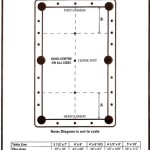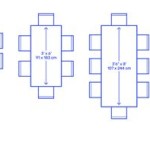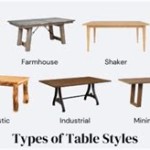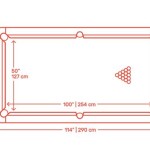How To Mark Out A Snooker Table
Marking out a snooker table accurately is paramount for ensuring fair play and adherence to the official rules of the game. Precise markings guarantee that spots are correctly positioned, baulk lines are straight, and the overall geometry of the table is compliant with established standards. This process demands meticulous attention to detail and the utilization of appropriate tools and techniques to achieve professional-level results.
Prior to commencing the marking process, a thorough inspection of the existing table is essential. This inspection should identify any preexisting markings, imperfections in the cloth, or irregularities in the table’s surface. Addressing these issues beforehand will prevent inaccuracies in the newly applied markings. Clean the table surface thoroughly using a billiard table brush to remove any dust, chalk, or debris. A lint-free cloth can then be used to gently wipe the surface, ensuring a smooth and clear canvas for marking.
The tools required for accurately marking a snooker table include a calibrated measuring tape (preferably steel), a straight edge (ideally a long, sturdy piece of wood or metal), a carpenter's pencil (or a similar marking tool that leaves a fine, visible line), a protractor or angle finder, and masking tape. For more advanced marking, a laser level can be beneficial, particularly for ensuring straight lines across longer distances. A spirit level is also useful for verifying that the table is perfectly level before marking, as any slope will skew the measurements.
Understanding the Official Dimensions and Layout
The official dimensions of a full-size snooker table are 12 feet long by 6 feet wide, measured from the inside edges of the cushions. The playing area, delineated by the cushions, is therefore slightly smaller than the overall external dimensions of the table. The accuracy of these dimensions is critical for professional play and should be verified before any marking commences. Smaller tables exist, often referred to as 3/4 size, 1/2 size etc, but the principles of marking remain the same, only scaled down. Refer to official snooker guidelines for precise dimensions if working with a smaller table.
The key markings on a snooker table include the baulk line, the D, the center spot, the pyramid spot, the black spot, the pink spot, the blue spot, and the locations of the colored balls along the baulk line. Each of these markings serves a specific purpose in the game and must be positioned with utmost precision.
The baulk line is a straight line running across the width of the table, 29 inches from the face of the bottom cushion (the cushion at the baulk end of the table). The D is a semi-circle centered on the middle of the baulk line, with a radius of 11.5 inches. The center spot is located exactly in the middle of the table's length and width. The pyramid spot, also known as the pink spot, is located exactly halfway between the center spot and the face of the top cushion (the cushion at the opposite end of the table). The black spot is located 12 3/4 inches from the pink spot towards the top cushion.
The blue spot is located in the center of the table, coinciding with the center spot marking. The yellow, green, and brown spots are positioned along the baulk line. Viewing the table from the baulk end, the green spot is to the left of the D, the brown spot is in the center of the baulk line, and the yellow spot is to the right of the D. The exact distances between these spots and the edges of the D are dictated by the rules and must be measured carefully.
Step-by-Step Marking Process
Begin by establishing the center line of the table. Measure the width of the table at both ends (close to the cushions) and mark the midpoints. Use the straight edge to connect these two points with a faint line. This line represents the longitudinal center of the table and serves as the basis for locating the center spot, pyramid spot, and black spot.
Next, measure the length of the table and mark the midpoint on the center line. This point represents the center spot. From the center spot, measure halfway towards the top cushion and mark this point as the pyramid spot (pink spot). From the pink spot, measure 12 3/4 inches towards the top cushion and mark this point as the black spot. Ensure all measurements are taken along the center line for accuracy.
To mark the baulk line, measure 29 inches from the face of the bottom cushion across the width of the table. Mark these points at several intervals and then use the straight edge to connect these points, creating the baulk line. Verify that the baulk line is perpendicular to the center line using a protractor or angle finder. The angle should be exactly 90 degrees.
To construct the D, locate the center of the baulk line. Using a compass or a pre-cut template, draw a semi-circle with a radius of 11.5 inches, centered on the midpoint of the baulk line. The semi-circle should extend towards the playing area.
The positions of the colored balls along the baulk line (yellow, green, and brown) require careful measurement. The brown spot is located at the midpoint of the baulk line (the center of the D). Measure the specified distances from this point to locate the green and yellow spots. These distances are defined in the official rules of snooker and may vary slightly depending on the specific governing body.
Once all markings have been made, review them thoroughly. Use the measuring tape and straight edge to double-check the distances and alignment of each marking. Any discrepancies should be corrected before proceeding. Once satisfied with the accuracy of the markings, use masking tape to create definitive lines for the baulk line and the D. These lines should be thin and precise, allowing for clear visibility during play.
Ensuring Accuracy and Addressing Potential Issues
Maintaining a consistent measurement technique is crucial for accuracy. Always measure from the same reference points (e.g., the face of the cushion) and use a calibrated measuring tape. Avoid parallax error by looking directly down at the tape measure when taking readings. Small errors can compound over longer distances, so meticulous attention to detail is essential.
The levelness of the table plays a significant role in the accuracy of the markings. An unlevel table will distort the perception of straight lines and distances. Use a spirit level to check the table's levelness before marking and adjust the legs as necessary to achieve a perfectly level surface.
The type of cloth used on the snooker table can also affect the marking process. Some cloths are more prone to stretching or shrinking than others. Take this into account when measuring and marking, and avoid pulling or stretching the cloth during the process. It’s often preferable to mark directly onto the cloth with a fine-tipped marker specifically designed for billiard fabrics. These markers leave a less permanent mark than standard pencils and are less likely to damage the cloth.
If the existing markings are significantly inaccurate or damaged, it may be necessary to completely remove them before applying new markings. This can be done using a specialized cloth cleaner and a soft brush. Exercise caution when removing markings to avoid damaging the cloth.
Laser levels can be used to project straight lines across the table, providing a visual guide for marking the baulk line and the center line. However, laser levels must be used carefully to ensure they are properly calibrated and aligned. Follow the manufacturer's instructions for proper use.
Regularly check and maintain the accuracy of the markings. Over time, the markings may fade or become obscured by chalk or debris. Clean the markings regularly and retouch them as needed to ensure they remain visible and accurate.
For professional or tournament-level play, it is advisable to consult with a qualified billiard table technician to ensure that the table is marked according to official standards. These technicians have the expertise and equipment necessary to achieve the highest level of accuracy.
By adhering to these guidelines and employing meticulous attention to detail, one can accurately mark out a snooker table, ensuring a fair and enjoyable playing experience. Proper markings are not merely cosmetic; they are fundamental to the integrity of the game.

Snooker Table Layout Dynamic Billiard Mississauga

Welcome To Fcsnooker Snooker Tables Markings For The D Baulk Line And All Coloured Ball Spots

Welcome To Fcsnooker Snooker Tables Markings For The D Baulk Line And All Coloured Ball Spots

Pool Table Layout Dynamic Billiard Mississauga

Marking Your Pool Table To Play Snooker Technical Considerations

The Markings On A Billiards Table Canadian Home Leisure

Dmark The Billiard Table Marker Spinster Billiards

How To Mark Your Pool Table Head Spot Foot And Line Full Diy Guide

Layout Of A Pool Table Billiards Snooker And Darts Te Ara Encyclopedia New Zealand

The Markings On A Billiards Table Canadian Home Leisure








